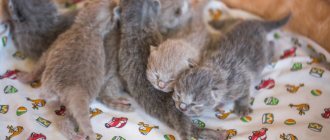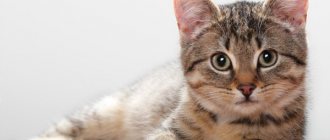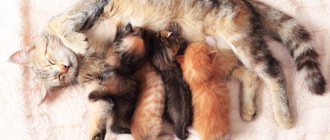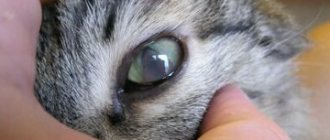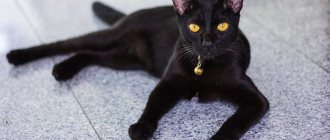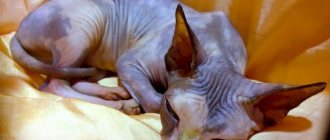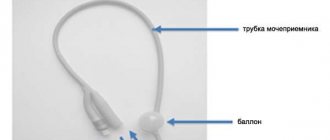A collection of tips THIS IS TIPS. TREATMENT AND RECOMMENDATIONS ARE TO THE Veterinarian. I AM ONLY A BREEDER.
giving birth to a cat, helping a cat during childbirth
| A cat's gestation period is 58-72 days. If the cat’s labor is good, then there is no need to use medications before and during birth. After birth, two hours after the last kitten, oxytocin can be administered to better cleanse the uterus and increase milk lactation. |
the use of medications during childbirth in a cat For experienced breeders, this advice is unnecessary, but for beginners I want to remind you that you are not a veterinarian. Therefore, use medications very carefully and do not try to pour and inject everything into the cat. Improper use of medications can seriously harm your cat.
Travmatin for a cat during childbirth Travmatin® acts on the neuroendocrine system, stimulates the production of endogenous (own) oxytocin, which leads to uterine contractions. In addition, Travmatin® has an analgesic and hemostatic effect. Even during normal childbirth without obstetric care, there is a risk of microtrauma to the mucous membrane of the cervix and vagina. Therefore, Travmatin® should be administered both at the beginning of labor and at the end of the process. This allows you to avoid complications both during childbirth and in the postpartum period, prevents inflammatory diseases of the genital organs and promotes normal involution of the uterus (when the uterus returns to its original state). The composition of Travmatin® in microdoses includes natural components created on the basis of plant raw materials, so it is absolutely harmless to the fetus and the mother in labor.
The dosage of the drug for cats is 1 ml. Travmatin® is injected subcutaneously into the withers area or intramuscularly. In addition, the drug can be given orally in 5-15 drops (if it is impossible to give an injection, a very small or nervous animal), if necessary (weakening of labor in case of large fetuses or large litter size), frequent administration is possible (every 15-20 minutes).
If the postpartum period is accompanied by severe bleeding from the genitals, the animal must be given an injection of Travmatin® and consult a doctor immediately!
Don’t panic, stay calm, keep Travmatin® on hand, and your animal will give birth naturally and easily.
Gamavit for a cat during childbirth Subcutaneously, 2 ml before birth or during childbirth as needed. Gamavit is used to normalize labor in complicated cases. The drug stimulates the smooth muscles of the uterus, accelerating and facilitating the birth process, and promotes rapid cleansing of the uterine horns from dead fetuses.
For weakened kittens, 0.01 ml subcutaneously.
oxytocin in a cat during childbirth Oxytocin has the ability to enhance contractions of the smooth muscle of the uterus and myoepithelium of the mammary gland.
Attention! Oxytocin can be released in different forms. Oxytocin 5 units and oxytocin 10 units. Recalculate the dosage in accordance with the purchased drug!
This drug is injected during weak labor. It causes contractions of the uterus. In most cases, oxytocin is not recommended until the first kitten is born. It is also strictly contraindicated in the case when the kitten is stuck in the birth canal.
Oxytocin is injected into the withers in a volume of 0.2-0.3 ml. One time. NOT INTO A FIGHT! If after 20 minutes there is no reaction, then inject again. In case of weak labor, they usually inject according to this scheme - 02. ml 3 times with a break of 20 minutes. You can inject intramuscularly, then the reaction will follow faster.
. Oxytocin is contraindicated during obstetrics in cases of a large fetus, its deformity, as well as in case of incorrect position and position.
a cocktail that stimulates labor in a cat. If you are afraid to administer oxytocin, administer a 10 ml s.c. cocktail. No risk at all, just pure benefit. Tested in prolonged labor.
The action of the cocktail is fundamentally different from the mechanism of action of oxytocin and similar drugs (oxytocin “works” at the level of nerve fibers, “forcing” the muscles of the uterus to contract, and the cocktail stimulates the contraction of the smallest blood vessels without affecting the nerves. Therefore, “uterine fatigue” does not is coming.
Moreover, if it is necessary to use oxytocin, it is recommended to inject such a cocktail “before that”.
In addition, the cocktail DOES NOT ALLOW uterine ruptures and bleeding, and the largest kittens are born remarkably and without problems only with its use (without the participation of oxytocin).
You can prick UNTIL INFINITY - as much as needed = uterine fatigue DOES NOT OCCUR.
The difference between subcutaneous, intramuscular and intravenous administration is the speed of action. Roughly speaking, the result occurs subcutaneously in 10 minutes, intramuscularly in 5 minutes, intravenously in an instant.
After the birth of Supposedly the last kitten, I always inject oxytocin. Cocktail - I inject for another 3 days after childbirth (1 injection per day, in the same dosage as during childbirth). and again - reinsurance, for possible eclampsia.
NOW THE RECIPE ITSELF: 4 ml (cube) glucose 4 ml (cube) calcium gluconate 2 ml (cube) ascorbic acid We select all components into one syringe, total volume = 10 ml (cube). Inject at the rate of 2 cubes per 10 kg of cat’s weight. Single dose for a medium-sized cat = 1 ml.
Inject after the birth of the first kitten.
Maintains the tone of the uterus and stimulates the release of clots, replenishes fluid loss and feeds, “washes out” the placenta, stimulates milk production. Very good during long labor.
cocktail to restore strength and energy calcium gluconate 10% -2 ml ascorbic acid - 1 ml glucose 5% - 7-10 ml For two subcutaneous injections of 10 ml every hour. The cat's weight is from 3.5 to 5 kg. Do you understand? not for stimulation, not for vitaminization, and not for prevention - To replenish what was lost.
This cocktail is used ONLY DURING childbirth (after 3-4 kittens) or AFTER BIRTH. To replenish lost: strength and energy (nutrition and fluids - glucose, stress relief and removal of toxins - vitamin C, calcium.)
calcium gluconate during cat birth Calcium gluconate or calcium borogluconate (1 ml intramuscularly)
Calcium gluconate is injected only INTRAMUSCULARLY (.), warmed up to body temperature (the required amount is drawn into a syringe and held in the hand until it warms up).
The drug gently enhances contractions and labor, and also promotes milk production. During childbirth, calcium is injected when regular contractions begin (see the cat's condition, if necessary). 1 ml at a time, bring to 4 ml.
After childbirth, a prophylactic dose of 1 ml once a week. If the cat shows the first signs of eclampsia, give it 1 ml in the morning and 1 ml in the evening for three days.
To relieve an attack of eclampsia, inject 2 ml, repeat after 30 minutes until the attack is completely relieved. The maximum total dose is 10 ml. You can drink calcium gluconate, but it’s useless!
In addition, it is advisable to give the cat a sedative; with the sedative, the signs of the disease go away much faster.
The veterinary drug calcium borgluconate is injected INSTEAD of calcium gluconate according to the same scheme, subcutaneously or intramuscularly. Do not solder.
Traumeel (traumatin) one drop in the mouth of a weakened kitten every 15 minutes for two hours. For cats, 0.5–2 ml subcutaneously or intramuscularly to relieve pain.
How to help a cat give birth at home
Pregnancy in a domestic cat is relatively quick, lasting 55 to 60 days. Some individuals give birth completely independently and human participation in this process is not important to them. British cats, Sphynxes, Maine Coons or Persians require the obligatory assistance of the owner during childbirth or even the presence of a veterinary obstetrician.
It is advisable to know exactly how much time has passed since the moment the animal was mated, in order to be prepared for the required time.
The approach of “day x” will be indicated by the so-called harbingers of childbirth, during which the expectant mother is a cat:
- begins to look for a secluded place to build a nest;
- becomes very affectionate with a person, requires special attention to himself;
- may refuse to eat;
- begins to lick the swollen mammary glands.
A few days before the expected birth, you need to prepare the necessary list of things that may be needed to help the cat and her cubs:
- Childbirth box. Place in a secluded, warm place;
- Disposable diapers and sterile wipes;
- Disposable syringes and medications if there is a possibility of complications;
- Vaseline oil;
- Sharp scissors;
- Disinfectant solution;
- Surgical or silk thread to tie the umbilical cord;
- Iodine or brilliant green.
We deliver a cat at home
It happens that all the due dates have passed, but the cat does not even think about giving birth. In such cases, you should definitely contact your veterinarian.
Induction of labor
Self-stimulation of labor can lead to complications.
Oxytocin
and its derivatives can provoke cervical rupture in a mother who is not ready for the process. Traditional methods will complicate and prolong childbirth and provoke weak attempts.
Primiparous females are often better than their “experienced” friends. This behavior is determined solely by the first experience. All that is required from the owner is to reduce the pet’s stress as much as possible by calming, stroking, and speaking kind words.
.
Sometimes it is necessary to resort to medicinal sedation, giving sedatives
to relieve tension.
If your cat needs help during the birthing process, she will let you know.
First aid for a giving birth cat is non-intervention.
Most often, mothers themselves know what needs to be done, but sometimes a little assistance is needed. When the pushing begins, you can place your palm under the hind legs so that mommy can rest. During pushing, spontaneous bowel movements may occur - you should keep cleaning supplies nearby.
An attempt to turn the kitten face forward during birth.
The appearance of the amniotic sac requires special attention. If the baby walks butt forward, you can try to turn him around
. Lubricate your little finger with Vaseline and carefully insert the shell back. Place the woman in labor on her hind legs, while supporting her front legs, and gently shake off her body. The kitten should turn around on its own in this way.
It is permissible to stroke all the time, lightly resting on the chest area. This will help with pushing. In the case when the water has already broken, the fetus is within visible limits, and the contractions have suddenly stopped, oxytocin can be used to stimulate contractions. For this, a tenth of an ampoule. The needle, after treatment, must dry out due to the destruction of oxytocin when interacting with alcohol.
You cannot pull the kitten out of the crotch. You can help widen the passage with a Vaseline-lubricated finger, carefully and very slowly pushing the boundaries. If the measures taken do not produce results, call a veterinarian immediately.
Normal course of labor
During the normal course of labor, you can help by pulling the afterbirth a little towards you and letting the woman in labor eat it. If the mother does not lick the baby, free him from the film, wipe him with a dry cloth, and give him to the mother.
In between contractions, the mother can feed the kittens, you can give her some water, but under no circumstances feed her. When the next contractions and attempts begin, the babies should be removed from her.
How many kittens, so many placentas?
It is necessary to compare the number of kittens and placentas. In nature, a cat eats the placenta, which contains nutrients.
It is imperative to ensure that the number of placentas is equal to the number of babies born. If this does not happen, you must independently remove the placenta from the mother’s womb.
The afterbirth remaining inside will create a pathogenic environment
, which will lead to serious inflammation and subsequent bad consequences. The appearance of the fetus with its paws forward is also a pathology. You need to carefully push it back in. With repeated contractions, the fetus may be delivered correctly.
The cat ruptures the amniotic sac during childbirth on its own.
The amniotic sac must be ruptured by the cat herself.
, otherwise, you need to tear the film yourself from the side of the baby’s face.
The newborn should squeak. If this does not happen, you can try to revive him. To do this, turn it over with its paws down, holding its head, shake it a little, pressing on the chest to allow fluid to drain out of the lungs. You need to act carefully so as not to damage the fragile cartilage.
If the cat no longer has babies, its belly becomes soft and elastic within half an hour. This can be determined by palpating the abdomen. However, this data does not apply to the case if oxytocin was used for stimulation. The abdomen may be tense for a longer period.
How to induce labor in a cat
It happens that more than 68 days have passed since the cat was mated, but labor still does not occur. Kittens grow inside the womb and take more and more energy from their mustachioed mother. The larger the kittens, the more difficult the birth process will be.
Every owner, in case of such a situation, should know ways to speed up the birth of his pet.
Stimulation drug
There are many medications for the obstetrics of animals. And some of them can induce labor in a cat.
In any case, before injecting or injecting your pet with any medicine, you must consult a veterinarian and carefully read the instructions for use of the drug!
Here is a list of medications that may be needed during childbirth:
- Oxytocin. A synthesized artificial hormone that causes uterine contractions. Use only as directed by a veterinarian! If used incorrectly, the drug can cause bleeding and even rupture of the cat's cervix;
- Gamavit. A drug to stimulate the smooth muscles of the uterus. Used in difficult cases to facilitate the birth process;
- Travmatin. A remedy for pain relief and regulation of contractions and pushing. It is used to prevent complications during childbirth, as well as to heal injuries to the external genitalia of the animal and prevent the inflammatory process.
- Calcium gluconate. Gradually enhances the animal’s labor and promotes milk production. After childbirth, it is used to relieve attacks of eclampsia.
INTERESTING: Eclampsia is a dangerous disease that manifests itself in cats that have recently given birth as an acute nervous disorder. The disease is caused mainly by a lack of calcium in the animal's body.
This metabolic disorder can lead to seizures and possible death.
Folk remedies
To stimulate labor in a cat, you can first take mechanical actions. The cat should be carefully placed in the “pooping” position and the belly should be massaged with gentle circular movements. Then, after putting on gloves, you need to dip your finger in Vaseline oil, insert it into the cat’s vagina about a centimeter deep and again carefully make circular movements. In this way, labor can be provoked in the animal.
Cocktail that stimulates labor
There are also cocktails, the recipe of which every self-respecting owner of a pregnant mustachioed pet must know.
This cocktail is indispensable when a protracted labor is imminent and the owner is afraid to administer oxytocin.
Recipe: 4 ml glucose, 2 ml ascorbic acid, 4 ml calcium gluconate. All components must be mixed in one syringe.
To induce contractions (and therefore childbirth), the injection must be subcutaneous or intramuscular, but only after the birth of the first kitten, at the rate of 2 ml of cocktail per 10 kg of cat. That is approximately 1 ml for an average weight cat.
Used for three days after birth to prevent eclampsia, 1 ml per day.
What to do at home?
How to induce labor at home?
To help a giving birth cat and speed up the birth process, it is recommended to use the drug Oxytocin. It is an artificial hormone that makes the uterus contract faster. However, this medication is not safe, so the first thing you need to do before using it is to contact the veterinarian who saw the pregnant cat. Improper use of the medicine may cause severe bleeding or cervical rupture.
The drug Travmatin will help speed up and relieve the pain.
You can also use another pharmaceutical product called “Travmatin”. If the owner sees that the cat is in pain, this medicine is perfect. It has an analgesic effect and allows you to regulate contractions. In addition, in veterinary practice the medication is used to prevent complications.
A pharmaceutical product called “Gamavit” will also help. In veterinary medicine, it is used to stimulate the muscles of the uterus. Often used in difficult situations to make the birth process easier and faster. It is also recommended to resort to calcium gluconate, which smoothly enhances labor and also provokes increased production of breast milk. This medication can also be used after the birth of offspring, as it effectively fights eclampsia. This pathology develops after childbirth and is a nervous disorder. Often the disease is caused by a lack of calcium in the body of the cat who gave birth.
The lack of this element not only affects the condition of teeth, bones and coat. It can also provoke seizures and lead to the death of your pet.
ethnoscience
For a homemade stimulating cocktail you will need an ascorbic acid preparation.
To induce labor, the owner will first need to put the pet in a position as if she is defecating, and then begin to massage the peritoneum. Next, it is recommended to prepare a cocktail that can be used instead of Oxytocin. You will need to fill the syringe with 2 ml of ascorbic acid, 4 ml of calcium gluconate and glucose. To force a cat to give birth, the injection must be given intramuscularly, but only before the first baby appears. The dosage is calculated as follows: 2 ml of the product per 10 kilograms of the pet’s body weight.
The cat can't give birth
When the animal strains, but this does not help, veterinarians recommend resorting to the medications described above. If, with the help of medications, the pet is unable to give birth, it is important for the owner to call a veterinarian as soon as possible or take the cat to the clinic. This is an important condition, since sometimes the pet requires resuscitation, otherwise it may die.
Kitten stuck
To carry out this manipulation, you should use Vaseline.
If the baby's head has already appeared, but the cat is unable to push it out, the owner will need to arm himself with Vaseline and sterile gloves. When a kitten is stuck in the birth canal, you need to carefully lubricate the vagina, then insert your finger into it and find the elbow folds of the cat's paws. The owner should grab both limbs and gently turn the baby from side to side, trying to move the paws forward.
Situations are not excluded when the afterbirth does not come out. In this case, you will also need to take sterile gloves, after which you need to insert your finger into the vagina, try to feel the afterbirth and remove it. If you can’t cope on your own, a veterinarian’s intervention is required. When a bubble has emerged, which often breaks inside the female, it should be broken independently, but your hands should first be disinfected.
A kitten is born dead
The baby will begin to breathe again after the passages are cleared of accumulated fluid.
If the owner discovers such a situation, it is important not to panic. Babies may only appear dead, which is often observed when the airways are blocked. To revive the cat, you need to use a pipette to clear the pathways, and then stimulate breathing by holding it by the limbs and holding it upside down. Next, the baby should be placed on the cat's chest. However, there are situations when kittens are actually born dead. If the cat has already given birth to 2-3 dead babies, and when you feel her peritoneum you can find another fetus, you need to visit a veterinarian. Sometimes a caesarean section is required.
First stage of labor
When the cat’s stomach drops and the kittens inside are shaking, there is very little time left before giving birth. A cat's labor can be divided into three main stages.
This stage can last up to 24 hours. It all starts with a decrease in the cat’s body temperature by about two degrees. The animal begins to behave restlessly and often licks under its tail. Some individuals vomit.
It is necessary to move your pet to a “nest” specially prepared for childbirth and continue to be close to her. It is advisable for any cat to give birth at home, because a familiar environment is calming and helps to reduce anxiety at this most important moment.
During the first stage of labor, your cat's water breaks, then her breathing quickens, her heart rate increases, and contractions begin. The animal begins to purr loudly and even scream. At this moment, the owner’s support in the form of soft stroking on the tummy and a calm conversation will not hurt.
Second stage of labor
At this stage, the abdominal muscles and diaphragm begin to move - strong attempts begin. The first kitten is moving towards a new life. The amniotic sac ruptures and some amniotic fluid leaks out of the cat's vagina. The cat at this moment lies on its side, in some cases stands or sits. Kittens, like humans, are born head first, although breech presentation is the norm.
After the kitten is born, the cat licks it, frees it from the amniotic sac, gnaws the umbilical cord and puts it to the chest.
Cat giving birth
Childbirth itself consists of several periods:
- preparation
– the cervix is dilated, lasts up to 8 hours; - contractions
- smooth muscles contract; - pushing
– the abdominal muscles contract; - alternating
contractions and pushing; - the release of the placenta
after the birth of all kittens.
After the kittens are born, the placenta comes out.
After the placenta is released, the uterus contracts for some time, and bloody mucous discharge is released.
Third stage of labor
The third stage of labor is the state of calm of the cat's uterus in the interval between the birth of babies. It lasts about fifteen minutes. During this period, the cat can drink some water. Often the cat also eats the afterbirth, which comes out after the kitten is born. But you should not allow your pet to eat more than two afterbirths. This can cause stomach upset for the new mother.
INTERESTING: The number of placenta during childbirth in cats should be the same as the number of kittens born. If the placenta does not come out, the owner needs to help his pet remove it. If this is not done, the cat may develop serious inflammation.
It is impossible to accurately determine the duration of labor in cats, because this is a very individual process. There are individuals who cope within a couple of hours, and for some, prolonged labor lasts up to 36 hours.
Physiology of pregnancy and childbirth in cats
The duration of pregnancy in cats varies from sixty to seventy-five days.
- Short-haired and hairless breeds carry their offspring for approximately 55–65 days
. - Long-haired females - up to 75 days
.
Pregnancy in cats lasts from 60 to 75 days.
The duration of pregnancy depends on the number of kittens
. The more babies a mother has inside, the faster labor can occur. Conversely, one or two babies may be born late.
Conception usually occurs after 25–50 hours, from which point it is customary to begin the countdown.
Phases of pregnancy
On the fiftieth day, the kittens begin to move actively.
- On the twentieth or thirtieth day,
the nipples begin to rise and become rounded. They turn pink and begin to peel off. The animal sleeps more, becomes more cautious, moves less, and begins to eat more. The abdomen increases by about one and a half centimeters, becomes rounded, elastic, and the embryo can be felt. - At the beginning of the fifth week,
the volume of the abdomen is approximately two and a half centimeters, the volume of the fetus reaches three and a half centimeters. - At the beginning of the sixth week,
the fruits descend into the peritoneum and stretch out, becoming cylindrical in shape. The belly gets bigger if there are more than two kittens inside. If there are one or two babies inside, the belly remains practically unchanged. It is strictly forbidden to palpate the female’s peritoneum at this time in order to avoid damage to the fruits. After the sixth week, the abdominal area increases laterally and takes on the shape of a pear. - Starting from the fortieth day,
accelerated development of the fetus occurs and fur is formed, which for the mother may mean a decrease in appetite. - On the fiftieth day,
the kittens begin to move actively. The harbingers are considered to be relaxation of the pelvis, and increased mobility of the sacral bone, swelling of the vulva and mucous discharge, and the appearance of colostrum. At this time, the cat is actively looking for a secluded place to build a nest.
Complications during childbirth
It happens that the normal course of labor may be interrupted by certain complications. The owner needs to be very careful, especially if the cat is giving birth for the first time.
How to help a cat during childbirth and what can cause complications?
What to do if a cat develops a bladder during childbirth
Most often, the amniotic sac ruptures while still inside the woman in labor. If the entire bubble comes out, you can help the cat break it by first disinfecting your hands.
What to do if the kitten is born too big
You need to wait for the kitten to partially emerge during the contraction, then carefully use your index finger, pre-lubricated with Vaseline oil, to move the skin from inside the cat’s vagina closer to the anus. And then you need to carefully grab the kitten and move it from side to side with gentle movements, thus helping it to be born.
What to do if a cat gives birth to dead kittens
If a cat cannot give birth to dead kittens, she definitely needs help. The only difference is that the kitten can be pulled by any part of the body, just to free the woman in labor from the dead fetus, so that severe inflammation with subsequent infection does not occur.
Complications during childbirth in a cat (pathological birth)
Any anomalies negatively affect the health of both cats and kittens. The most common cause of complications during childbirth is weak labor (weak contractions of the cat's uterus). There are two types of this phenomenon:
- 1. The primary slight tone of the uterus is that the body does not have the required amount of a hormone called Oxytocin. It enters the blood from the pituitary gland and affects the frequency of uterine contractions. Often PLTM (primary light uterine tone) is associated with a lack of calcium. In most cases of difficult births, it turns out that the cat has a deficiency of both hormones. In such cases, injections are given using medications such as Pitocin (Oxytocin) and calcium gluconate. They will help the uterus contract stronger and more frequently.
2. Secondary slight tone of the uterus is that the organ stops contracting due to severe exhaustion of the cat during labor. VLTM occurs when childbirth is much more difficult and longer than the animal’s body can withstand.
There are three stages of labor:
Helping a newborn kitten
There are cases when a cat, having just given birth to her cubs, does nothing towards them. Then the owner of the new mother must get down to business.
The kitten needs to be helped to free itself from the amniotic sac and gently blow into its nose. Then squeeze the umbilical cord at a distance of a couple of centimeters from the baby, tie it with surgical thread and trim it with sterile scissors. The wound should be smeared with green paint, and the baby should be pushed towards the mother’s nipples.
When the kitten begins to eat milk, the cat's maternal instinct will take over and she will continue to take care of the offspring without the help of the owner.
To prepare for the birth of your mustachioed pet, you can read a lot of information, watch videos on the Internet and follow all kinds of advice. And if everything goes smoothly, the cat can easily give birth. But, no matter what knowledge and skills the owner of a pregnant cat has, if during childbirth there are doubts about the correctness of what is happening, it is imperative to take action and call a veterinary obstetrician. It’s better to play it safe so that everything goes well for the new mother and her cubs.
How to induce labor in a cat, what to do if the expectant mother is overdue? Is it possible to stimulate contractions and what are the consequences? Let's understand the intricacies of the birth process and possible complications.
When you need help
Is it possible to induce labor in a cat on your own? In some cases, it is not only possible, but also necessary. As a rule, pregnancy in cats lasts 55-60 days. A slight delay in the birth of kittens is normal, but if the animal does not give birth 68-70 days after mating, measures must be taken. The babies grow in the mother's womb, becoming larger and larger, and the larger the kittens, the more complications the birth will be.
© shutterstock
Normal and abnormal course of labor
Prevention of all possible complications during childbirth begins with caring for a pregnant cat . As soon as you discover that your pet is pregnant, regardless of whether mating was planned, she must be shown to a veterinarian.
A cat's pregnancy can be determined from 2–3 weeks using a blood test. At 3–4 weeks, the expectant mother's mammary glands swell. As the gestation period increases, the following signs are observed:
- Increased hunger.
- Redness of the nipples.
- Toxicosis.
- Slight but constant weight gain.
- Behavioral changes - frequent meowing, restlessness, unusual affection or irritability.
During the normal course of pregnancy, by about 5–6 weeks, the pet’s belly becomes noticeably rounded. If gestation proceeds without complications, the cat receives decent care, has no genetic defects, and birth occurs from 64 to 71 days of pregnancy.
Important! During the normal course of pregnancy, before the onset of contractions, the cat should not experience any discharge from the genitals. The only exception is early rejection of the mucus plug, which can occur several weeks before birth.
It will be easier for an inexperienced owner to cope with the situation if the nest for birth is prepared in advance. It is necessary to monitor the cat’s behavior; most often, she herself chooses a suitable (from her point of view) place. You can take the initiative and equip a nest for your cat from a spacious box. In order for the expectant mother to feel safe, the box must be closed (have a roof).
During the first contractions, you may find that the cat is restless, constantly entering the nest, or looking for a suitable place to give birth to kittens. The pet can meow loudly and attract the attention of the owner, especially if she is about to give birth for the first time. The first contractions bring discomfort, but the cat successfully hides the pain. The owner may not notice the discharge of amniotic fluid and the rejection of the mucous plug, since the cat licks the genital area.
As the labor process progresses, contractions will intensify and the interval between them will decrease. When the interval is reduced to 20–30 seconds, the cat will lie down on its side and prepare to push.
The first kitten takes longer to be born than all the others; to expel it, the cat will need to make 3-4 strong attempts. The total duration of the process from the start of contractions to the appearance of the first kitten can take from 2 to 24 hours. Normally, contractions last up to 12 hours, and pushing at the birth of the first kitten lasts up to 1 hour.
Note! After the birth of the first kitten, the remaining babies should appear at intervals of 10–20 minutes.
As soon as the baby is born, the cat licks its face, gnaws the umbilical cord and eats the afterbirth. If the woman in labor does not pay attention to the kitten, and the expulsion occurs too quickly, the pet may be in rapid labor. This complication is associated with severe pain, so it is advisable to immediately remove the kittens from the nest, remove fluid from the respiratory tract, rub them and place them on a heating pad.
How long does it take for a cat to give birth?
Based on the nature and course of labor itself, three phases are distinguished.
Moreover, the first and second phases are periodically repeated with each born kitten, and the third, the final, passes very quickly and almost imperceptibly.
First phase
First phase
consists of weakening the cervix, vagina and the beginning of uterine contractions. Contractions “change places” with relaxations. The pelvic muscles are relaxed, the perineum becomes more elastic and increases in diameter.
The process itself has not yet begun, but you can already feel, if you put your hand on the stomach, the movement of the kittens inside. Heavy breathing, change in behavior - the pet often runs to the box, rummages through it, indicating the completion of the first phase.
In primiparous females, this phase can last about 36 hours
.
Second phase
Second phase
characterized by more frequent and painful contractions, which is provoked by the movement of the first kitten towards the exit. At the very edge of the perineum, the amniotic sac is visible, which bursts and some fluid flows out. At the same time, the cat pushes, helping the baby to be born.
This blood sac is the first kitten.
The process lasts from five minutes to half an hour
.
Third phase
All kittens were born. The cat will lick the last one and will be ready to get rid of the placenta.
Third phase
occurs after the birth of all kittens and involves the release of the placenta. In the normal course, the amniotic sac comes out with each kitten, but it happens that it is delayed and two come out together, after the birth of the next baby.
Prevention of prolonged labor
With high-quality care and a normal pregnancy, most cats give birth to offspring without outside help. A young mother is quite capable of setting up a nest for herself, preparing for childbirth on her own, licking all the kittens and pushing them towards the nipples.
As long as the birth occurs without complications, owner intervention is not required, but many women in labor prefer to be observed by a trusted person. Observe the expectant mother; by her behavior you will understand whether she wants your presence during childbirth. If a cat is hiding, try to watch it from the side.
Do not forget that physical activity is very important for the normal development of kittens and preparing the body for childbirth. Try to provoke your cat to play and run. In addition to natural stimulation of the birth process, physical activity during the entire pregnancy will allow the pet to maintain a normal weight.
Important! Obesity in pregnant cats increases the load on the heart, purification and respiratory systems. Significant excess weight often leads to complications during childbirth.
A cat may deliberately delay giving birth if she is unsure of the well-being of the expected offspring. What
Preparing to give birth to a cat
First you need to prepare the so-called “nest”. The cat will not want to give birth on a bare floor or thin bedding; she will begin to look for a more comfortable place.
Take a wide, shallow box and place a soft mattress on the bottom. You can sew it by stuffing it with padding polyester, or use an old blanket/towel. Make sure that there are no threads sticking out of the bedding. It is also worth choosing non-slip fabric on which kittens can crawl safely.
Before the actual birth, place the cat in the “nest”, she should settle down in it. If the pet does not like the impromptu “maternity hospital”, she will begin to look for a more suitable place within the apartment.
To convince the animal that the “nest” is safe, place it in a dark and quiet place. When you find a common language with your pet, place disposable pet diapers on the bottom; they can be purchased at a pet store or use regular baby diapers from a pharmacy.

